Decauville
Decauville (French: [dəkovil]) was a manufacturing company which was founded by Paul Decauville (1846–1922), a French pioneer in industrial railways. Decauville's major innovation was the use of ready-made sections of light, narrow gauge track fastened to steel sleepers; this track was portable and could be disassembled and transported very easily. The first Decauville railway used 400 mm (15 3⁄4 in) gauge; Decauville later refined his invention and switched to 500 mm (19 3⁄4 in) and 600 mm (1 ft 11 5⁄8 in) gauge.
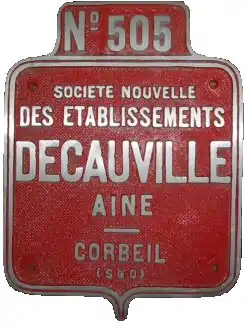
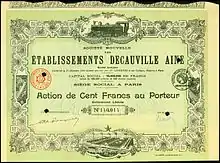
| Track gauge | ||||||||||||||||||||||||||||||||||||||||||||||||||||||||||||||||||||||||||||||||||||||||
|---|---|---|---|---|---|---|---|---|---|---|---|---|---|---|---|---|---|---|---|---|---|---|---|---|---|---|---|---|---|---|---|---|---|---|---|---|---|---|---|---|---|---|---|---|---|---|---|---|---|---|---|---|---|---|---|---|---|---|---|---|---|---|---|---|---|---|---|---|---|---|---|---|---|---|---|---|---|---|---|---|---|---|---|---|---|---|---|---|
| By transport mode | ||||||||||||||||||||||||||||||||||||||||||||||||||||||||||||||||||||||||||||||||||||||||
| By size (list) | ||||||||||||||||||||||||||||||||||||||||||||||||||||||||||||||||||||||||||||||||||||||||
|
||||||||||||||||||||||||||||||||||||||||||||||||||||||||||||||||||||||||||||||||||||||||
| Change of gauge | ||||||||||||||||||||||||||||||||||||||||||||||||||||||||||||||||||||||||||||||||||||||||
| By location | ||||||||||||||||||||||||||||||||||||||||||||||||||||||||||||||||||||||||||||||||||||||||
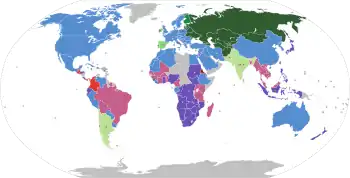 |
||||||||||||||||||||||||||||||||||||||||||||||||||||||||||||||||||||||||||||||||||||||||
History
Starting in 1875, his company produced track elements, engines and cars. Those were exported to many countries, in particular to the colonial possessions of European powers.[1] In 1878 Paul Decauville was given permission to build the Jardin d'Acclimatation railway in order to demonstrate passenger transport operations on his railway system during the Exposition Universelle of 1878.
Military use
The French military became interested in the Decauville system as early as 1888 and chose the 600 mm (1 ft 11 5⁄8 in) gauge track to equip its strongholds and to carry artillery pieces and ammunition during military campaigns. Decauville track was used during the French military expeditions to Madagascar and Morocco.
The Maginot line was built with both external and internal 600mm railways, the former served by combustion engines pulling supply trains from 1,435 mm (4 ft 8 1⁄2 in) standard gauge marshalling yards[2] behind the front, and the latter, served by electric locomotives taking over the loaded wagons inside the fortifications. Tracks inside the fortresses went from the munitions entries in the rear all the way up to the fighting blocks, where ammunition loads were transferred to forward magazines using overhead monorails.
Similar feldbahn equipment was used in German South-West Africa where Otavi Minen- und Eisenbahn-Gesellschaft built the 600 mm (1 ft 11 5⁄8 in) gauge Otavibahn.[3]
By the First World War, the Decauville system had become a military standard, and the French and British eventually built thousands of miles of trench railway track. The Germans had a similar system, with normalized engines.[4]
Civilian use
A Decauville railway was used in the construction of La Plata, Argentina, in the 1880s, and transported dignitaries from the mainline trains to the site of the founding ceremony.
During the 1889 exposition, Shah of Persia Nasereddin Shah who was a visitor got interested in the system and ordered 20 wagons and some rails to be installed in Tehran for Tehran – Rey Railway. Decauville railways were widely used in construction yards, quarries, farms, cane fields and mountain railways up to the 1950s. The company also produced road vehicles and construction engines.
Decauville tram installations for henequen plantations in the Mexican region of the Yucatán, were so extensive (approximately 4,500 kilometers of track) that the system became the de facto mass transit system for the region. Some ex-haciendas of the area still have small operating, usually burro (donkey)-powered, Decauville systems.
Decauville designed the steam tramway and cars used in Saigon in 1896.
Two Portuguese beaches, Barril and Caparica, have seasonal tourist trains using the Decauville system (600 mm or 1 ft 11 5⁄8 in gauge), totalling 10 km of track.
Gallery
 Decauville track in the Maginot Line in the French Alps
Decauville track in the Maginot Line in the French Alps Turntable
Turntable Preserved Decauville locomotive, built for the West Melbourne Gasworks in Australia and now on the Puffing Billy Railway
Preserved Decauville locomotive, built for the West Melbourne Gasworks in Australia and now on the Puffing Billy Railway Decauville system tourist train at Costa da Caparica, Portugal
Decauville system tourist train at Costa da Caparica, Portugal Decauville track from Transpraia, Costa da Caparica, Portugal
Decauville track from Transpraia, Costa da Caparica, Portugal Decauville track on a small bridge, Costa da Caparica, Portugal
Decauville track on a small bridge, Costa da Caparica, Portugal Decauville track junction, Costa da Caparica, Portugal
Decauville track junction, Costa da Caparica, Portugal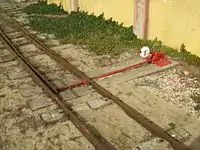 Decauville track switch, Costa da Caparica, Portugal
Decauville track switch, Costa da Caparica, Portugal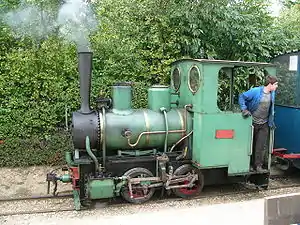 Decauville 0-4-0wt steam locomotive, Hauts-de-Seine, France
Decauville 0-4-0wt steam locomotive, Hauts-de-Seine, France
See also
References
- Small, Charles S. (April 1971). "Decauville Locomotives in Australia". Australian Railway Historical Society Bulletin: 88–94.
- rds
- Shaw, Frederic J. (1958). Little Railways of the World. Berkeley, Calif.: Howell-North. 37&38. OCLC 988744.
- Taylorson, Keith (1996). Narrow gauge at war, 2. East Harling, UK: Plantway press. ISBN 1-871980-55-0.
External links
| Wikimedia Commons has media related to Decauville. |
| Wikimedia Commons has media related to Military rail transport in World War I. |
- M. Decauville (1884-07-19). "Portable Railways". Scientific American. New York (Supplement 446). A paper read before the Institution of Mechanical Engineers .
- http://www.decauville.nl
- Map of Decauville railways in the Yucatan, Mexico
- Light Railways April 2013, has an article with illustrations on portable railways such as Decauville.
- Documents and clippings about Decauville in the 20th Century Press Archives of the ZBW
